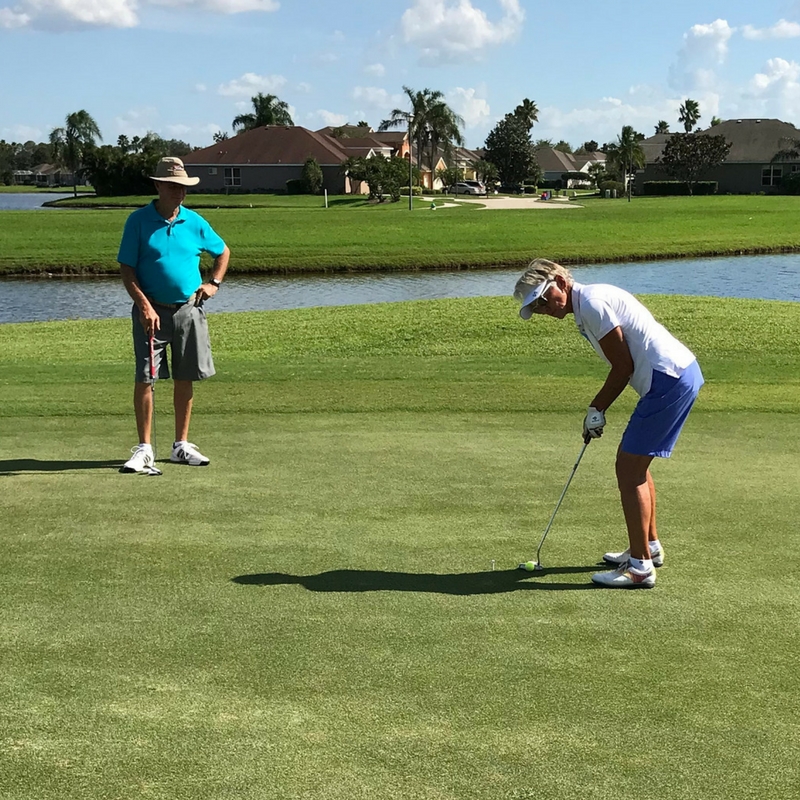 What youth golf lesson strategies do you use with your children?
What youth golf lesson strategies do you use with your children?
Do you just take them to the course when you go to play? Are they involved in junior programs at a golf academy?
Obviously, depending on their age, maturity, skill level, etc. the strategies may or may not need to change.
As more kids grow up in dual-income homes and/or single-parent homes, it is important to have a plan that works for the parents but more importantly supports the growth of their child into adulthood.
With youth sports running rampant through many communities, many parents are frantically looking for the best youth golf instruction, youth golf camps, youth golf schools, youth golf tips or a youth golf program to allow their child to get ahead of the pack.
Here are the youth golf lesson strategies that you need to implement with your kids (some will surprise you)…
1. Don’t Start With Golf Lessons Or Instruction Too Soon
I know this sounds crazy coming from somebody that teaches golf for a living.
I have had parents become frustrated with me because I tell them that the best thing for their children is to let them play and keep it fun for them and not put them into a golf academy.
How many kids look like a natural? They tend to quickly figure it out.
Obviously, this comes with a caveat. Again, it will depend on their age, current skill level, maturation, and current playing goals. I am sorry to be the one to break it to you but… your kid is probably not going to be the next Tiger Woods.
As a matter of fact, the odds are against him or her playing the PGA Tour or LPGA Tour for a living. But… they can become the best version of themselves.
They can become a very good player that could eventually be better than Tiger Woods while learning life lessons through golf and becoming a responsible adult. Is that not a win for everyone?
2. Give The The Right Junior Golf Equipment For Them
Most of the current parents that learned how to play golf were given a chopped-off club from our parents or grandparents set. A set that did not come close to fitting them.
Although the length may or may not have been close to being correct, the weight of the clubhead was WAY too heavy for most of those that begin playing really young.
Luckily, the junior golfers of today do not have to deal with that challenge as fitting and proper weighting can make it easier for the player.
A company like US Kids Golf does fitting and builds golf clubs for children that not only are built to proper length but are also built with properly weighted club heads making. With the proper fitting at an academy, the clubs are easier for the kids to full swing.
3. Do Not Try To Be Their Coach/Let Them Call The Shots
Speaking from experience, this is a difficult one to pull off as a parent.
All parents want to help their kids be the best “whatever it is” that they can be.
Keep in mind that you are there to do what they want to do and to make golf fun.
I have often told the story that when my daughter was young, she liked to hit balls into bunkers when we would go out and play. My first inkling was that of a normal parent and traditional golfer.
However, after thinking about it, the target that she is aiming for is much smaller than the green. If she can hit that then she will be able to hit the green when she decides that she wants that to be her target. This kept it fun for her and was one of the reasons that she wanted to play golf at that age.
Keep in mind that until the child decides that they want to play competitively, the rules are what you and your child decide that they are.
Once your junior golfer makes the decision to play competitively, the game still needs to be fun for them and not just a grind-taking youth golf lesson after lesson.
Unfortunately, I have witnessed many good young players burn out at an early age. They need time to figure it out themselves and learn through those mistakes.
4. How Often Or How Much Should They Practice Golf Including Instruction
When setting up a practice plan for kids, some would say that there is a fine line here.
As a parent myself, it can be difficult to know when your child “doesn’t want to do something” and when they are maybe just a little tired or feel like being lazy.
If your child is in junior high school or younger, I would leave it up to them.
Think back to when you were their age and had to take some sort of lessons because our parents said that you “had” to do something after school.
Just because you were made to do something like take piano lessons, singing lessons, or kids golf instruction, it does not mean that the time that you spent was making you better or more importantly wanting to do more of that activity.
Once they are in high school and are wanting to play the game at a competitive level, they should be setting goals and keeping track of their progress along with their instructors.
It is really important that around this time that they find friends with the same types of goals and aspirations. I have learned that the “pack” mentality from a golf course or a golf academy program, can keep them focused and motivated.
5. How To Maximize Playing Time
The game is typically known to be played in nine-hole or eighteen-hole increments. That does not mean that it HAS to be played that way.
Depending on the age, maturity, skill level, and attention span of your junior player, they may only want to play two holes or four holes. Luckily, many junior programs have gone to starting players with this type of format.
My wife loves to tell people that she plays the game.
To her, playing consists of hitting a bucket of balls and playing the first four holes. She does not even play from the forward tee markers she plays from the 250-yard marker on the par-five, the 150-yard marker on the two par fours, and the 100-yard plate on the final hole, a par three.
After that, she goes and sits in the cart and is happy with that amount of playing. If it is not a competition… Who Cares???
She has fun and she wants to go often. Your children will be the same way.
To maximize your playing time, it is smart to find times that are not as busy to take your kids to the golf course.
This way once you leave the tee, there will not be a parade of people behind you that are pushing you and wanting to play through. It makes it less stressful for everyone… including you.
6. Keep Golf Fun For Your Kids (And You)
If your kids are not in high school yet, the main goal is to keep the game fun for them so they want to keep playing.
It used to be that in order to be a good junior player, it meant standing on a practice tee and performing youth golf drills for hours upon hours (Did I mention it was hot out there?).
Whether your junior player is practicing by themselves, with you or with their friends from the pack, most of these junior golf drills can be turned into competitive games. Many of today’s junior golf programs gear their curriculum to learning through games.
Playing games and making practice competitive keeps the game much more fun for every player no matter their age. Just look at the popularity of TopGolf sweeping the country. Many beginner players enjoy themselves at these facilities because they are able to play multiple types of games.
7. Be Present With Your Kids
This does not mean “be their coach” and micro-manage every full swing, short game shot, or putt that they make. It simply means let children know that you are there and you want to spend time with them.
This means putting the phone away, not answering emails, not texting, and not taking phone calls and communicating to your child, without words, that say “I see you.”
If you want to be close with your children, it takes work just as any other relationship that you have. Trust me… The years will go by faster than you would like for them to go.
8. Junior Programs Or Lessons Need To Make It Safe To Fail
Look… not every round is going to be a great round, they are not going to win every tournament and will not feel great after every single instructional session. So then what?
Your little one needs to know that their self-worth is not dependent on that one round or that four-round tournament. This is much more important than building a “champion golfer.”
They are going to fail at various things in their lifetime. This gives you an opportunity to mold how they going about improving on those mistakes and/or failures.
You want to refrain from talking about what “they” have done and talk more about the effort that was given.
As long as your little one is giving full attention and effort to what they are doing, they will eventually figure out a way to do it. They just need YOUR encouragement.
The solution may not come as fast as they (or you) want, but they will figure it out. In any failure, positive things still happen and are something to build on going forward.
9. Communicate With Your Kids On Their Level
Making it safe for your children to fail will slowly gain the trust of your child. This will allow you to talk about subjects that are outside of the sports world.
Any parent will tell you that communicating with their child can be a difficult and at times even an impossible task depending on their age. This game could be the vehicle that allows you the connection.
It is now your job to work on your communication skills to create the best relationship that you can with your child.
Conclusion
Some of the above youth golf lesson strategies may have surprised you.
With the kids feeling pressure while simply taking a youth golf lesson, it can be WAY too much for them to handle.
Many golfing parents think that if their little ones are not taking instruction in a golf academy program by the time they are three years old then, they are behind the curve to get a college scholarship or even to eventually play a tour.
This is simply is not true.
I have known little kids that have won world titles at the age of five and end up barely making their high school golf team. Yes, this is a true story.
The goal of all parents should be to find a program that produces champion people and not just champion golfers.
Kids are kids and their interests will change. However, using the above youth golf lesson strategies and finding the best golf academy program for you and your little ones, you will be off to a good start to keep them playing the game!
If you liked this article, become a member of The Ball Flight Academy!
Change Your Ball Flight Today!
Read other posts from this category…

Online Golf Academy
There are many online golf academies that offer golf instruction and/or golf lessons to help you learn how to play golf or learn how to become a better player. From the mechanics of the full swing, short game, chipping, bunker

Solid Putts: Know Where The Center Of Your Putter Face Is
Do you have trouble hitting solid putts? Do you stand over short putts and doubt that you can stroke it on the proper line? Do you truly know where the center of your putter face is? Do you make what

What Are The Parts Of A Golf Club?
Whenever I have a new student in front of me, there is one thing that I can guarantee. I will go over the parts of a golf club. Of course, most players assume they already know all of the golf

Driver Fitting: 5 Factors To Know Before The Fitting
Driver Fitting In Sarasota What you should know before you go and get a driver fitting has become more and more confusing to the average golfer when looking to buy the correct clubs. In this article we will talk about

Homeschool Golf Lessons In Sarasota – Lakewood Ranch – Bradenton
The Ball Flight Academy – Home School Golf Lessons Home School Golf Lessons are being offered for students in Sarasota, Bradenton, Lakewood Ranch, Parrish, Venice, and other surrounding areas. Brad Myers, PGA has had many successes working with junior
GRAA Top !00 Golf Instructor in the US at The Ball Flight Academy
Brad Myers, PGA started The Ball Flight Academy to further assist his players to reach their golfing goals no matter if they are taking private golf lessons or online golf lessons.
After graduating from New Mexico State University with a degree in Professional Golf Management, Brad has taught at top golf facilities in the United States including the TPC at Sawgrass, Alabama’s Robert Trent Jones Golf Trail, The Woodlands Country Club, and Resort as well as the TPC at The Woodlands.
Brad Myers is currently a golf coach in Sarasota - Bradenton, Florida, and holds multiple certifications from…
- PGA of America in Teaching and Coaching.
- Trackman – Level 2
- Swing Catalyst – Level 2
- Titleist Performance Institute (TPI) – Level 1
- US Kids – Certified Golf Coach
In addition, Brad Myers, PGA is an Amazon Best Selling Author with his first book Golf Shots and Unicorns – Set Up Basics.
- Virtual Golf Lessons - February 9, 2025
- Winter Golf Training: If You Must Go Indoors… - October 1, 2024
- 3 Day Golf School - June 4, 2023

